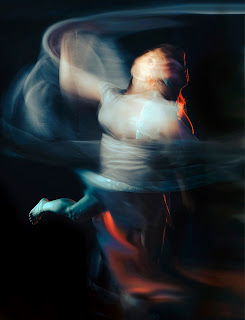Dawn Woolley
My artistic practice encompasses performance, photography, video, and installation. I examine my experiences as a neoliberal subject in contemporary consumer culture through a queer, feminist and anti-capitalist lens. Ideas of embodied presence and liveness are played with and called into question in my work. I view my work as self-portraiture, but not in the traditional sense. In some of the work, such as The Substitute series, I create photographic substitutes of myself in order to examine the act of looking and being looked at.
In Visual Pleasure I posed on a stage with cut-out furniture and struggled to maintain the position I have allocated myself – that of the object of desire. On first reading these images appear to reduce the female subject to a 2-dimensional representation but she is captive in a world that she built up around herself. During the studio shoots, I positioned my body, angled the furniture cut-outs to minimize reflections, and directed my assistant to take the photographs. As muscle cramp set in, the heat of the studio lights melted the glue connecting the cutout’s wooden supports and the scene fell down around me. The task of holding the image together inspired the Cut to the Measure of Desire live performances.
Cut to the Measure of Desire is a series of performance installations in which I embody my femininity as a state of perpetual, fallible exhibitionism. Using the language of symbolism in Dutch still life and genre painting I create scenes of excessive sexuality. Like Dutch genre paintings, each gesture and prop is carefully chosen to symbolise promiscuity, commerce and desire. I pose within the scene, an imperfect being concealed within a 2-dimensional idealised world. My knees become misshaped from kneeling on a concrete floor for prolonged periods of time and I am repulsed when sharing a gallery window with a skinned rabbit as we both sweat in the hot sun. The aim to uphold the illusion of perfection is futile and I suffer in the attempt.




I like too that you indulge the other themes of 18C Dutch painting of Death and Mortality, but for myself I'm glad never to have had that sort of melt-down on set
ReplyDeletethe idea of failing to uphold perfection and the futility of this is at the heart of things being "performed" rather than just a staged event. that is so interesting. also, adding the layer of printed cutouts which are flimsy and basically illusions seems to support the idea.
ReplyDeleteAnd very reminiscent of the experience of being a parent, with a continuing sense of always getting it wrong: until one day, they say "you know what dad, you did get it right"
DeleteHello - this is Dawn - thanks for your comments. I am really interested in the idea of pose and staging as a way of thinking about how we perform aspects of gender. I'm currently preparing for an installation and performance in Berlin that focuses on gender and gesture in selfie (and self-portraiture more widely). It will also consider the attempt and failure to uphold a perfect image - by having a 'font stage' and 'back stage' that are both visible to the audience, and using domestic surveillance cameras to record the performance.
ReplyDeleteI have been a big fan of the 'Cut to the Measure of Desire' series since discovering it a couple of years ago while studying, and am so glad to have rediscovered it through this project. I feel that any woman can position themselves within the images, but still feel as though an outsider, as while the woman is there and present with euro-centric features of beauty (blonde hair, stockings, trendy clothing on a slim frame) but we dont see her face. It's like the idea of watching yourself watch yourself and so on, an absence from the presence. She seems to exist in these uncanny spaces, familiar domestic settings but twisted and made eerie, again messing with our perceptions of the absent and present of this woman and femininity as a concept, what makes femininity, what takes it away?
ReplyDeleteDuplication of Flemish painting iconography gives good results, but it is not revealing. It was already. In addition, others shape us so much as to what extent we allow them. Sometimes the theory differs from practice.
ReplyDelete